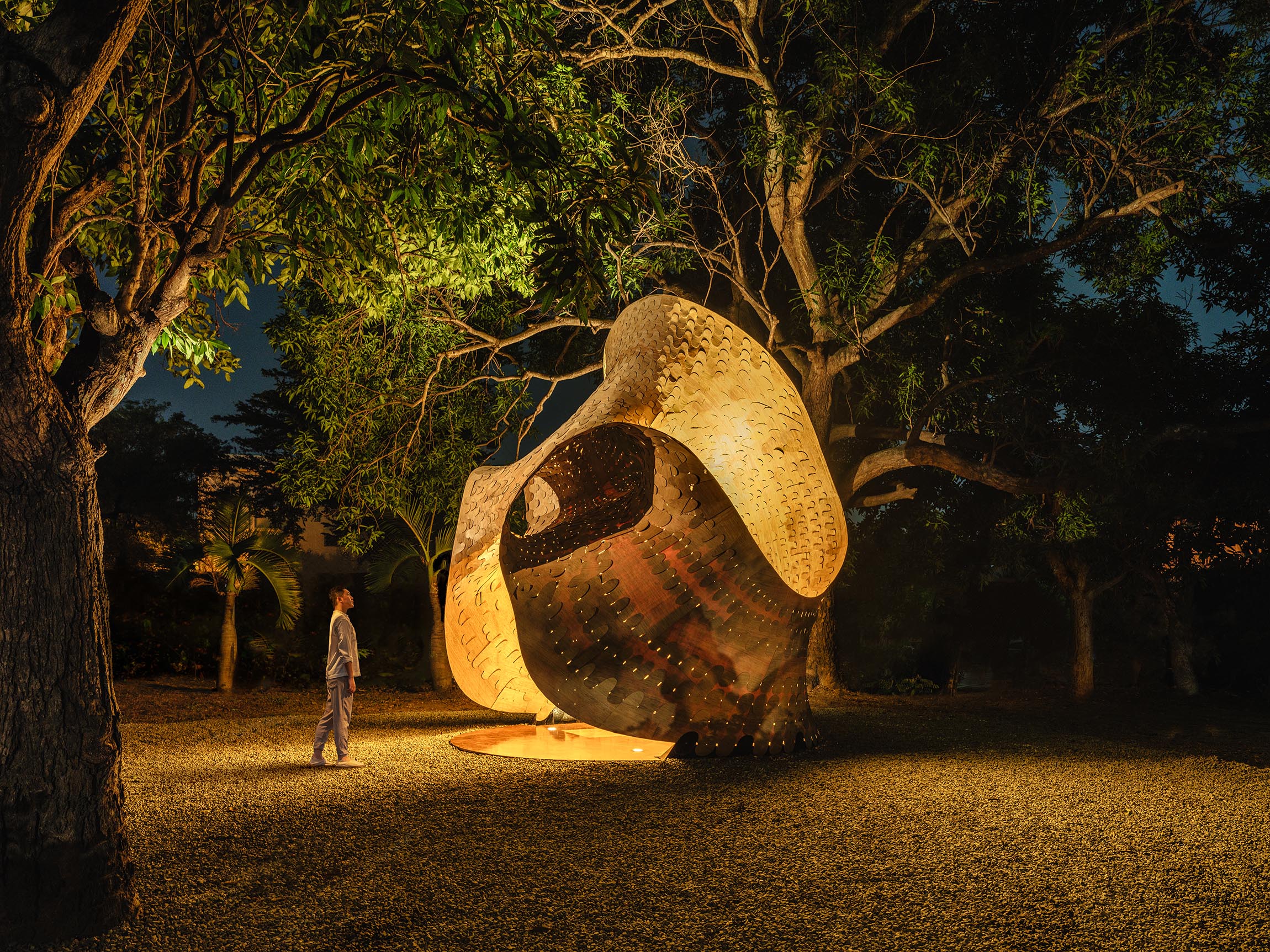
In today's focus on sustainability, bamboo is widely discussed as a potential building material due to its natural characteristics that make it suitable for construction. Bamboo is known for its strength and flexibility, and it is typically used in its original form as poles in structures. However, this approach often leads to significant variations in the material due to differences in growth conditions, making it challenging to use consistently.
"Porosity" seeks to combine the concept of "engineered wood" with natural materials by incorporating bamboo composites. It reinterprets the potential of bamboo by layering thin bamboo veneer sheets both vertically and horizontally, resulting in a lightweight and resilient material. These material properties enable new design possibilities, highlighting the potential for lightweight and curved bamboo structures.
Its circular form is concealed within a dense forest, and during the day, it appears to resemble a bamboo grove, with bamboo and wood colors blending together. When night falls, the interior lighting casts light outward, illuminating the irregular surfaces. The light flows along the curves, clearly defining the geometric interplay in the 3D space. Light and shadows reveal the material's fibers through the thin bamboo sheets, creating a sense of lightness and showcasing the traces of fabrication.
This work is located in the Alishan Forest Railway Garage Park in Chiayi City, Taiwan. Its circular form is concealed within a dense forest, and during the day, it resembles a bamboo grove, with the colors of bamboo and wood blending together. When night falls, the interior lighting casts light outward, illuminating the irregular surfaces. The light flows along the curves, clearly defining the geometric interplay in the 3D space. Light and shadows reveal the material's fibers through the thin bamboo sheets, creating a sense of lightness and showcasing the traces of fabrication.
『疊舞竹曲』為2022構竹林鐵新銳展之展出作品之一,行政院農業委員會林務局為推廣台灣竹材,並適逢阿里山小火車重新通車之時刻,邀請全台多個設計團隊分別就台灣豐富的原生自然材料『竹才料』提出設計小尺度建築的構築方案,形成一沿著小火車從嘉義市區一路停靠各站而上阿里山的系列竹構體驗展覽。
在永續發展為重的今日,竹子因具有作為良好構築之自然材料特性,被廣泛與討論作為建造材料的可能性。而竹子具有強而有力的韌性與彈性,因此,目前大多以原竹型態經過適當處理後,以桿狀方式備運用於構造物當中,而如此一來,材料之間由於生長情況差異(例如:竹節的數目、彎曲、長短等…)往往具有巨大之變異性,難以被系統化運用。而「疊舞竹曲」試圖結合目前自然材料中之「工程木材」概念,以竹複合材(竹片+玻璃纖維材料),透過疊加垂直與水平交互分布之薄竹皮,重新詮釋竹材之可能性,形成一具有優良韌性與彈性之輕盈薄板材料,而透過材料的轉變,進一步帶領型態之解放,重新展現輕盈彎曲型態之竹構可能。
「疊舞竹曲」作品位於嘉義市區阿里山森林鐵路車庫園區當中,其環形之身影藏於一茂密的樹林間,在白日行經的旅客如經過竹林般,望見竹與木色相間匆匆,而當夜色降臨,在作品內部設置的光源(色溫3000K)由內部打出,照映在不規則的曲面上,光沿著曲面流動,幾何的內外兩面被光影清楚的分界於3D的空間當中,而光影從薄竹板中透出纖維線條,不僅呈現輕盈更呈現出了構築的痕跡。而光影更進一步從整個自由的造型「疊舞竹曲」間竄出,光芒散落成星星在包覆的暗空間裡、光芒射出在樹梢上、光芒撒在地上把樹葉都變成黃色的沙,瞬間經過的旅客不再匆匆經過,而是停留下來駐足項是發現森林間發出獨特光亮的構竹旋律,吸引著人漸漸靠近,沿著光線、沿著彎曲,擾動著整場樹林間光影的旋律。
設計與研究人員|王識源 、 盛郁庭、 鄭中杰、 曾慶芸、 盧彥臣、 宋非凡、 洪維澤、 羅浚銓、 謝明皓 、 胡哲禎
助理 | 楊承泰、 謝文濬 、 蔣庭萱、 盧敬倫、曾泊芯、 劉晨心
結構分析|原型結構 原型結構工程顧問有限公司、ROSO機器人建造實驗室
材質|竹複合材(竹片+玻璃纖維材料)、金屬
燈光設計|偶得設計
攝影|定影影像
展覽|2022構竹林鐵新銳展 (策展人| 陳冠帆)
指導單位|行政院農業委員會林務局
主辦單位|社團法人臺灣竹會
協辦單位|阿里山林業鐵路及文化資產管理處
展覽時間|2022/11/14~
"Porosity" seeks to combine the concept of "engineered wood" with natural materials by incorporating bamboo composites. It reinterprets the potential of bamboo by layering thin bamboo veneer sheets both vertically and horizontally, resulting in a lightweight and resilient material. These material properties enable new design possibilities, highlighting the potential for lightweight and curved bamboo structures.
Its circular form is concealed within a dense forest, and during the day, it appears to resemble a bamboo grove, with bamboo and wood colors blending together. When night falls, the interior lighting casts light outward, illuminating the irregular surfaces. The light flows along the curves, clearly defining the geometric interplay in the 3D space. Light and shadows reveal the material's fibers through the thin bamboo sheets, creating a sense of lightness and showcasing the traces of fabrication.
This work is located in the Alishan Forest Railway Garage Park in Chiayi City, Taiwan. Its circular form is concealed within a dense forest, and during the day, it resembles a bamboo grove, with the colors of bamboo and wood blending together. When night falls, the interior lighting casts light outward, illuminating the irregular surfaces. The light flows along the curves, clearly defining the geometric interplay in the 3D space. Light and shadows reveal the material's fibers through the thin bamboo sheets, creating a sense of lightness and showcasing the traces of fabrication.
『疊舞竹曲』為2022構竹林鐵新銳展之展出作品之一,行政院農業委員會林務局為推廣台灣竹材,並適逢阿里山小火車重新通車之時刻,邀請全台多個設計團隊分別就台灣豐富的原生自然材料『竹才料』提出設計小尺度建築的構築方案,形成一沿著小火車從嘉義市區一路停靠各站而上阿里山的系列竹構體驗展覽。
在永續發展為重的今日,竹子因具有作為良好構築之自然材料特性,被廣泛與討論作為建造材料的可能性。而竹子具有強而有力的韌性與彈性,因此,目前大多以原竹型態經過適當處理後,以桿狀方式備運用於構造物當中,而如此一來,材料之間由於生長情況差異(例如:竹節的數目、彎曲、長短等…)往往具有巨大之變異性,難以被系統化運用。而「疊舞竹曲」試圖結合目前自然材料中之「工程木材」概念,以竹複合材(竹片+玻璃纖維材料),透過疊加垂直與水平交互分布之薄竹皮,重新詮釋竹材之可能性,形成一具有優良韌性與彈性之輕盈薄板材料,而透過材料的轉變,進一步帶領型態之解放,重新展現輕盈彎曲型態之竹構可能。
「疊舞竹曲」作品位於嘉義市區阿里山森林鐵路車庫園區當中,其環形之身影藏於一茂密的樹林間,在白日行經的旅客如經過竹林般,望見竹與木色相間匆匆,而當夜色降臨,在作品內部設置的光源(色溫3000K)由內部打出,照映在不規則的曲面上,光沿著曲面流動,幾何的內外兩面被光影清楚的分界於3D的空間當中,而光影從薄竹板中透出纖維線條,不僅呈現輕盈更呈現出了構築的痕跡。而光影更進一步從整個自由的造型「疊舞竹曲」間竄出,光芒散落成星星在包覆的暗空間裡、光芒射出在樹梢上、光芒撒在地上把樹葉都變成黃色的沙,瞬間經過的旅客不再匆匆經過,而是停留下來駐足項是發現森林間發出獨特光亮的構竹旋律,吸引著人漸漸靠近,沿著光線、沿著彎曲,擾動著整場樹林間光影的旋律。
設計與研究人員|王識源 、 盛郁庭、 鄭中杰、 曾慶芸、 盧彥臣、 宋非凡、 洪維澤、 羅浚銓、 謝明皓 、 胡哲禎
助理 | 楊承泰、 謝文濬 、 蔣庭萱、 盧敬倫、曾泊芯、 劉晨心
結構分析|原型結構 原型結構工程顧問有限公司、ROSO機器人建造實驗室
材質|竹複合材(竹片+玻璃纖維材料)、金屬
燈光設計|偶得設計
攝影|定影影像
展覽|2022構竹林鐵新銳展 (策展人| 陳冠帆)
指導單位|行政院農業委員會林務局
主辦單位|社團法人臺灣竹會
協辦單位|阿里山林業鐵路及文化資產管理處
展覽時間|2022/11/14~
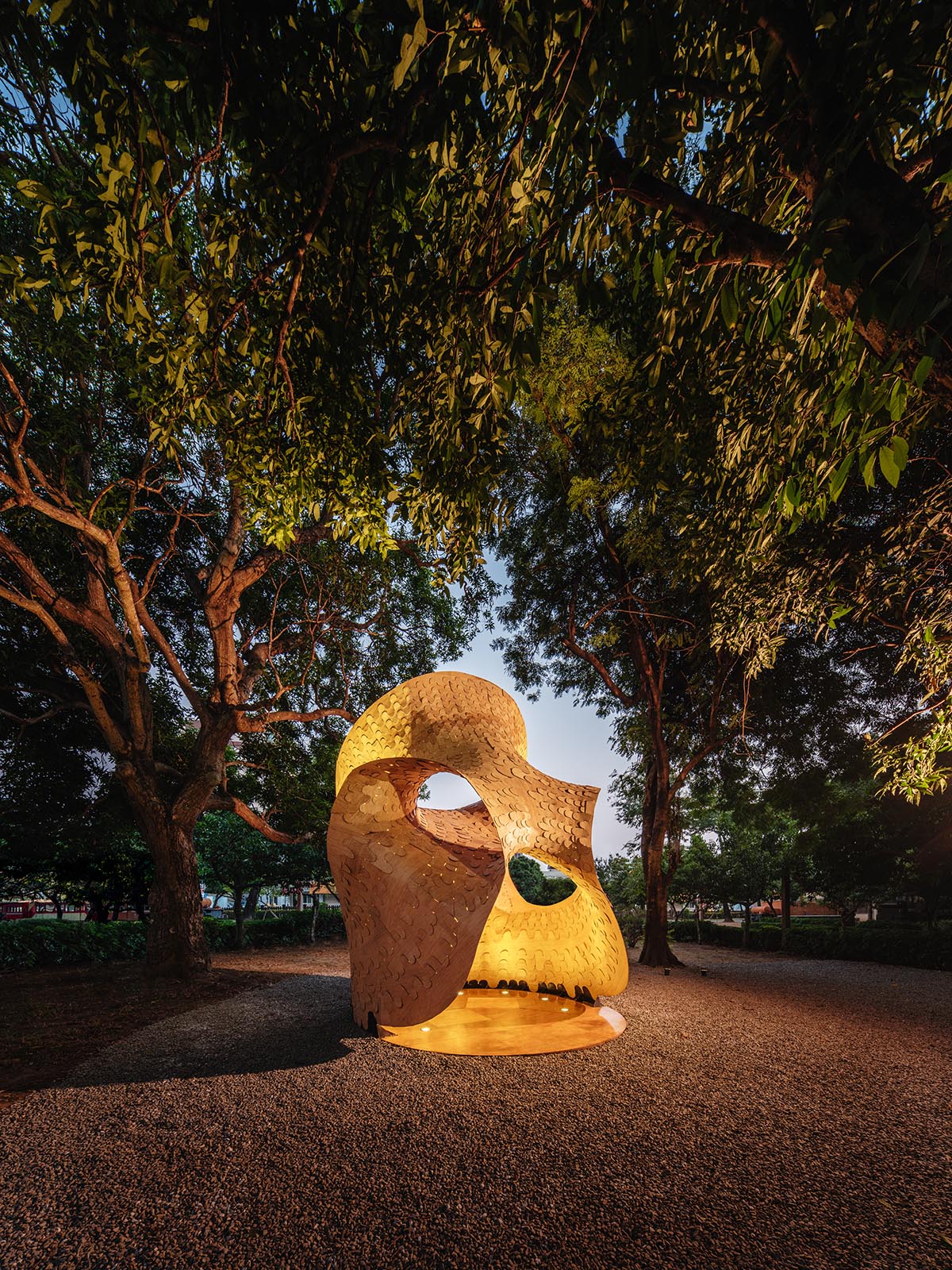
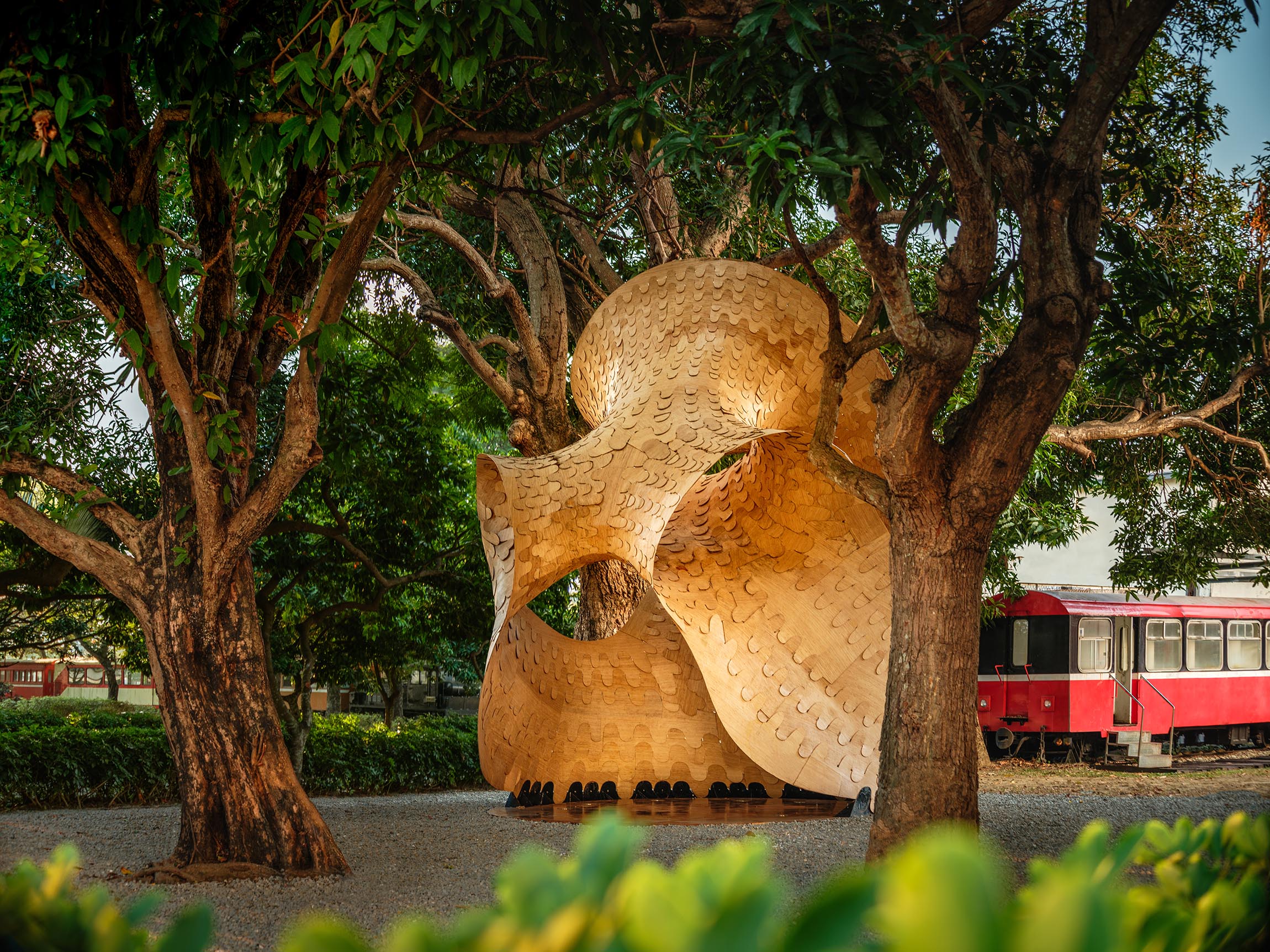
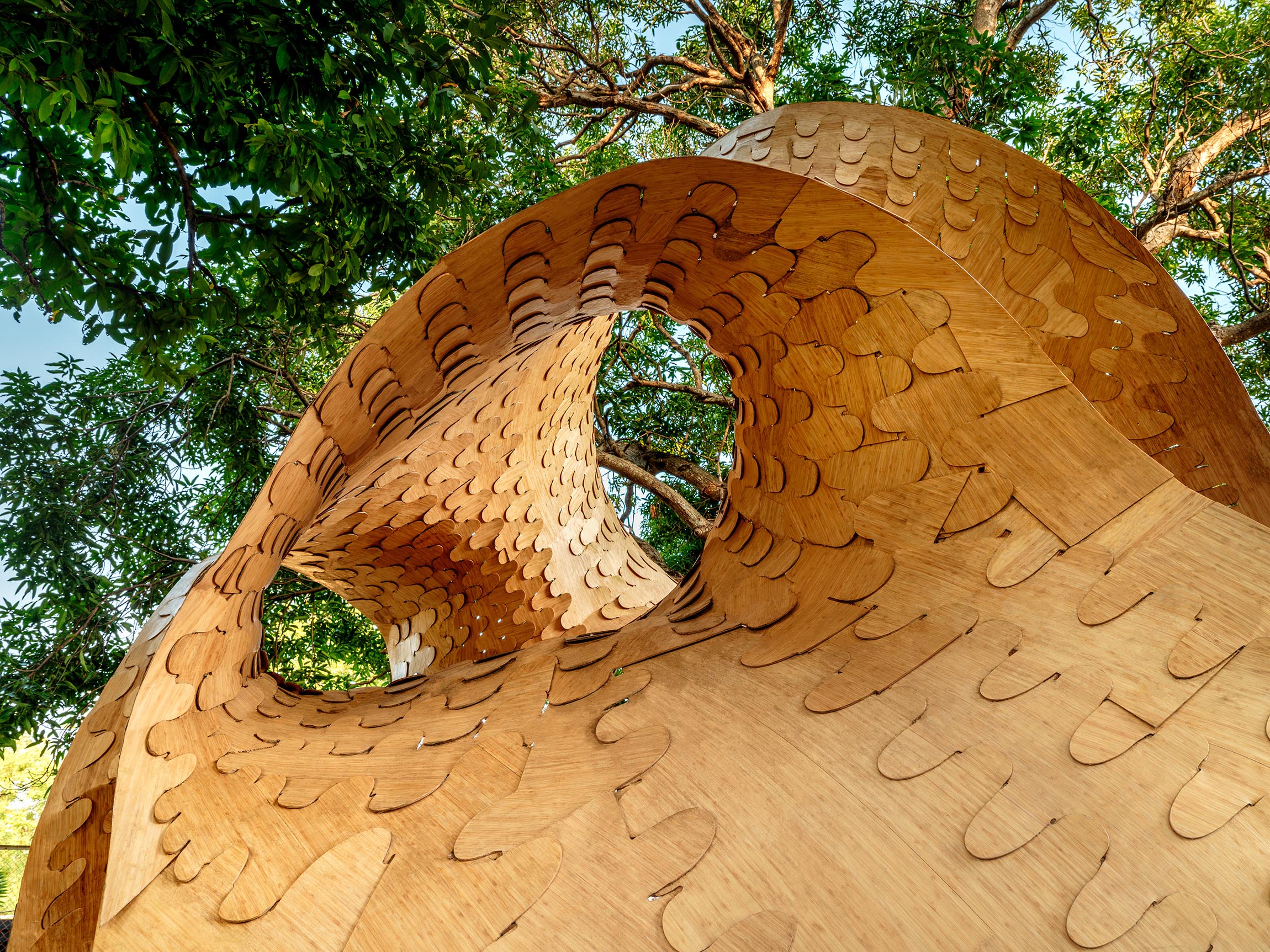

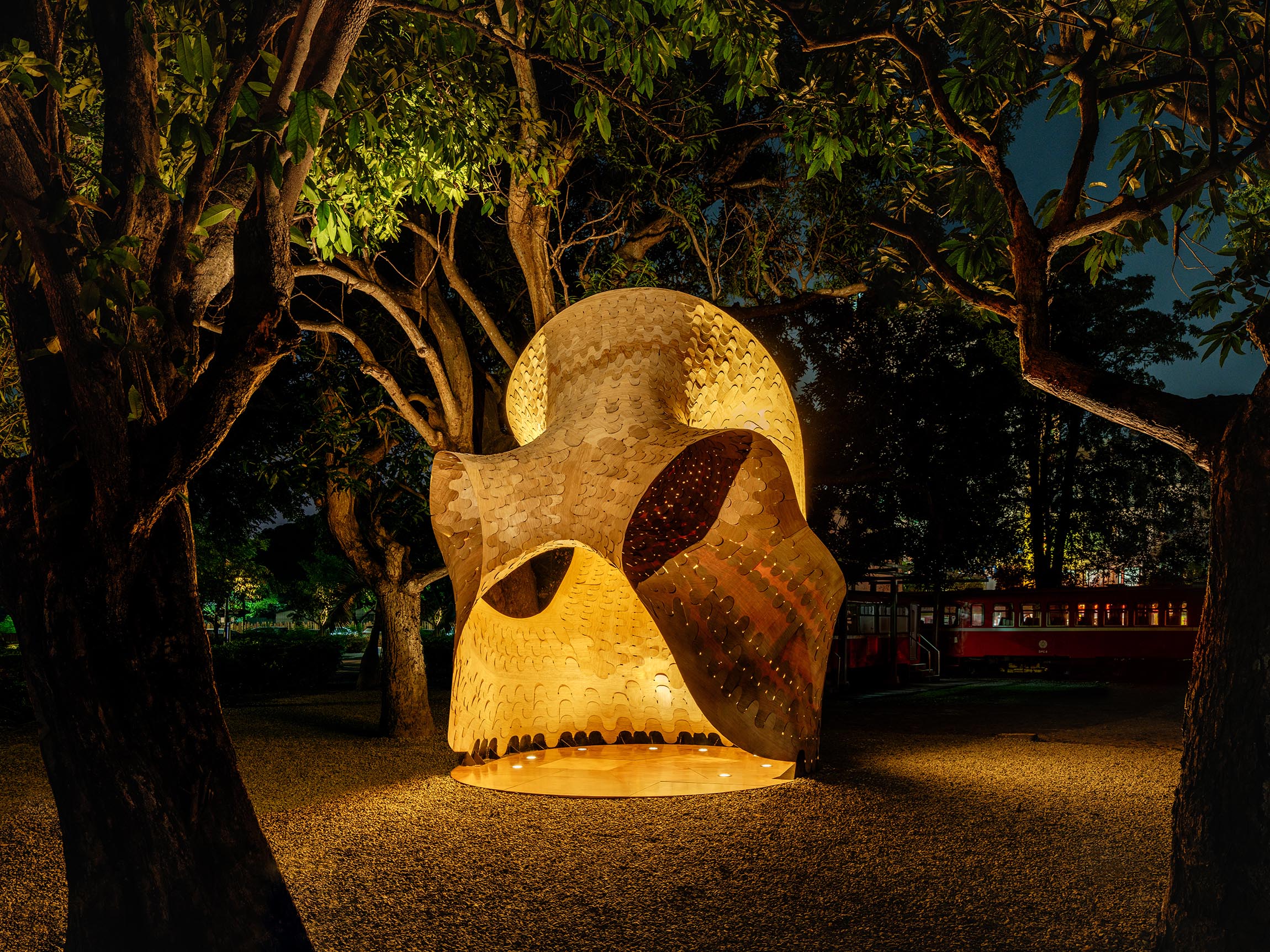
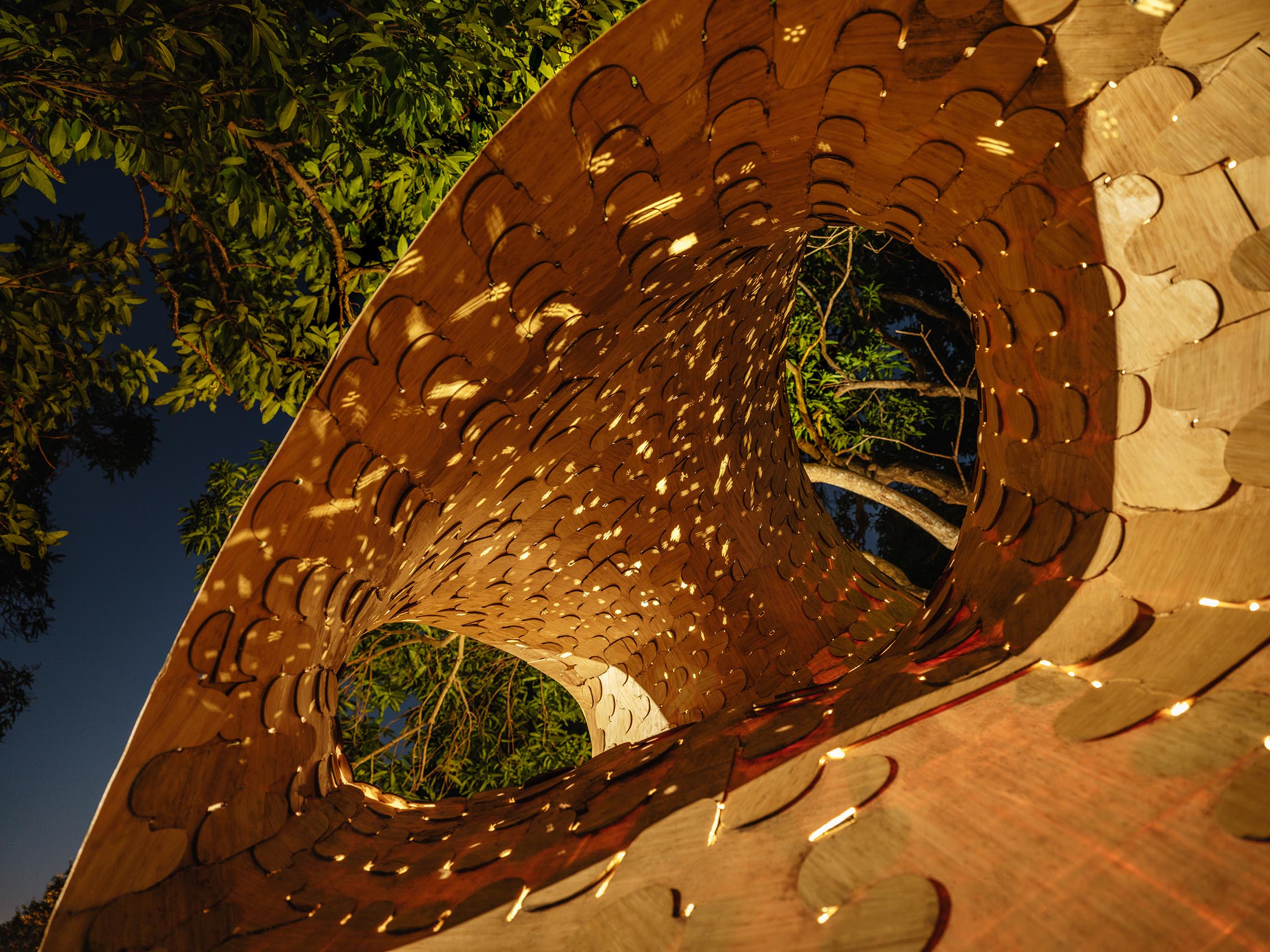
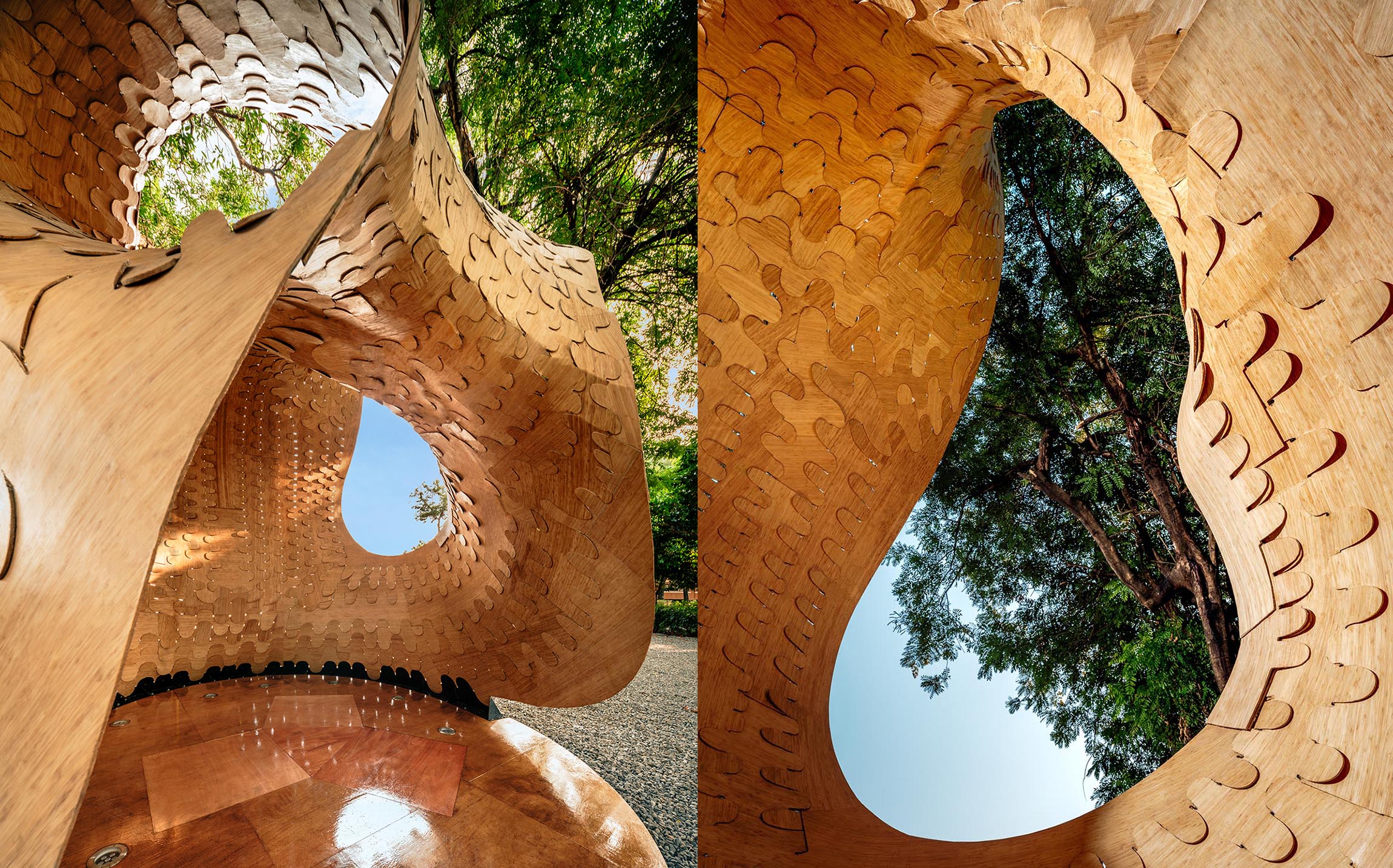
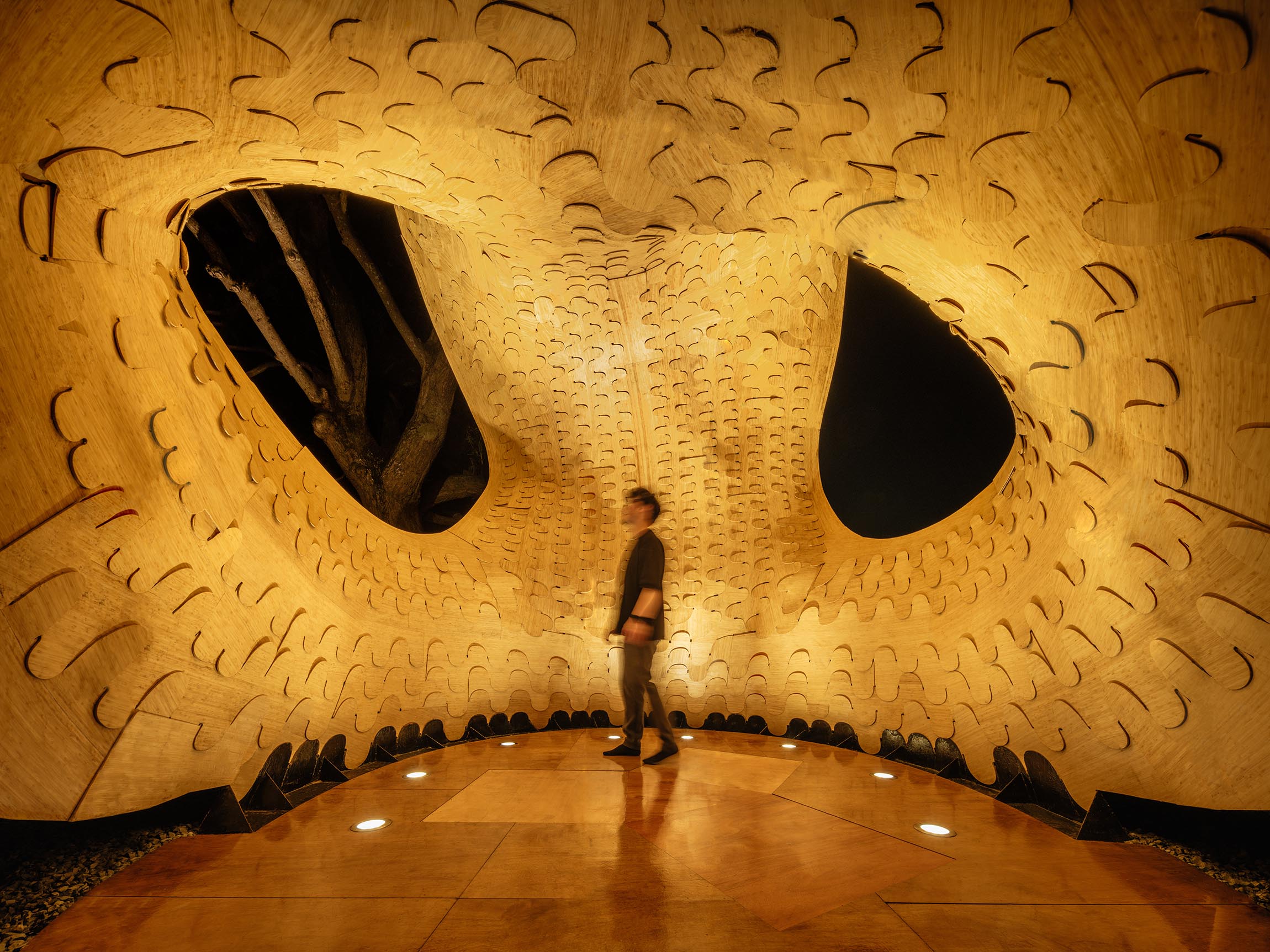
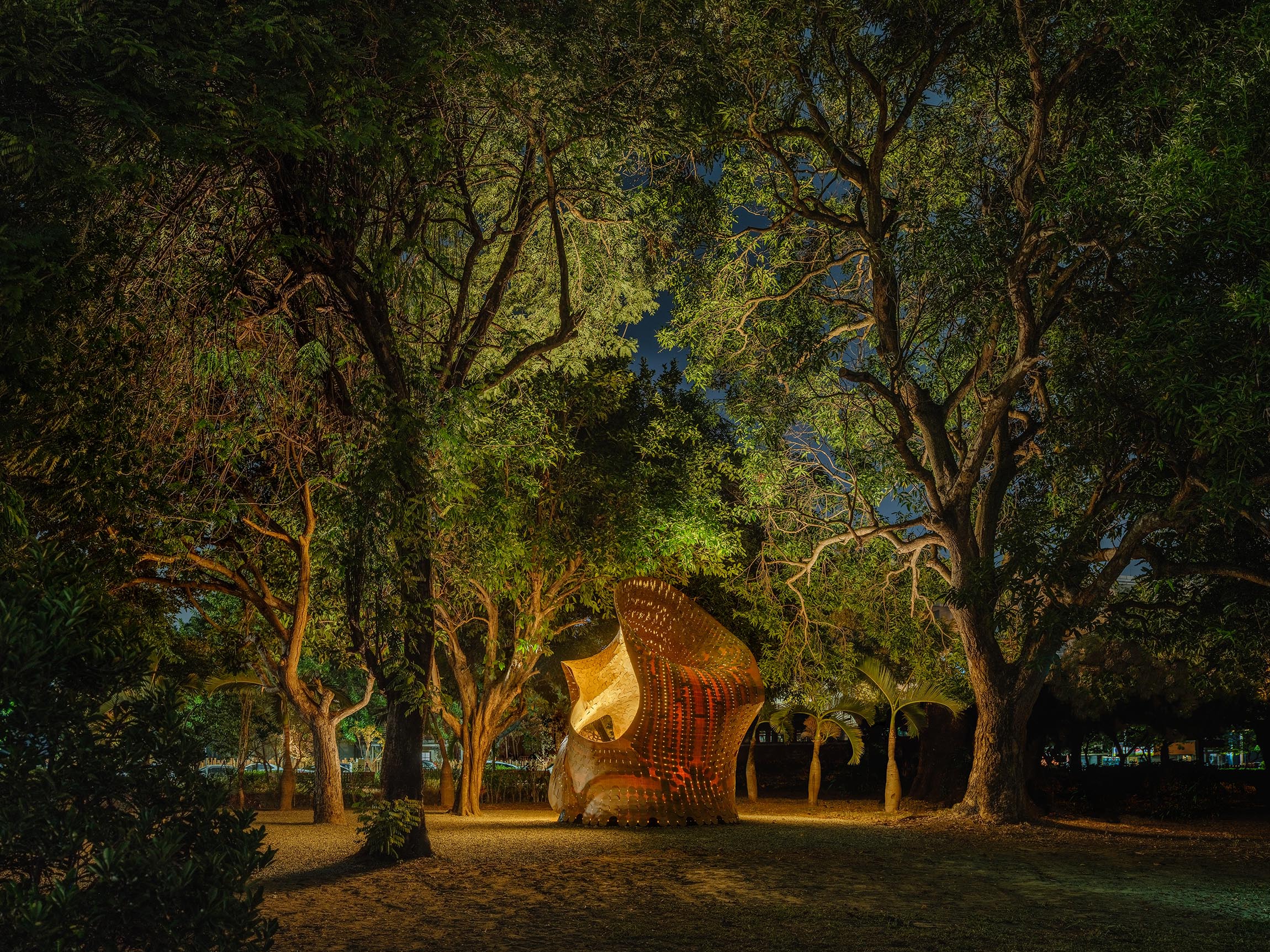
ABOUT
ROSO是一個前衛且跨學科的研究團隊。實驗室的主要目標為利用創新的機器人技術與運算設計思維,提供智能建造的流程,並利用當今各式各樣的新興科技相互碰撞下,開啟更多〈建築的想像力〉與〈建造的可能性〉之討論。
ROSO is an interdisciplinary research team. The main objective of the laboratory is to use innovative robotics technology and computational design thinking to provide diverse intelligent construction processes and solutions. Through the collision of various emerging technologies, ROSO aims to open up discussions on "the imagination of architecture" and "the possibilities of construction.
ROSO是一個前衛且跨學科的研究團隊。實驗室的主要目標為利用創新的機器人技術與運算設計思維,提供智能建造的流程,並利用當今各式各樣的新興科技相互碰撞下,開啟更多〈建築的想像力〉與〈建造的可能性〉之討論。
ROSO is an interdisciplinary research team. The main objective of the laboratory is to use innovative robotics technology and computational design thinking to provide diverse intelligent construction processes and solutions. Through the collision of various emerging technologies, ROSO aims to open up discussions on "the imagination of architecture" and "the possibilities of construction.
